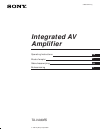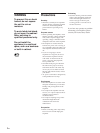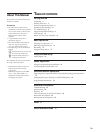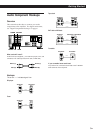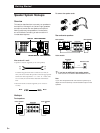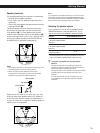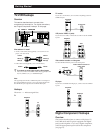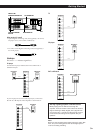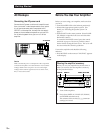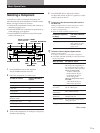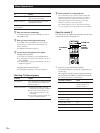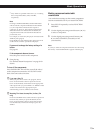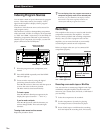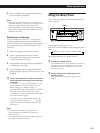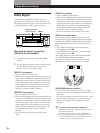
7
EN
Getting Started
Getting Started
Speaker placement
For the best possible surround sound, we recommend:
• The best quality speakers possible
• Front, center, and rear speakers of equivalent size
and quality
• Positioning of speakers at the same distance from the
listening position (A).
The center speaker, however, may be moved closer,
but not beyond the straight line connecting the two
front speakers (B). The rear speakers may also be
closer to listening position than the front speakers (C),
to suit the configuration of your room. If the surround
effect is still inadequate, adjust the CENTER DELAY
and REAR DELAY parameters (see page 16).
A
C C
A
45°
90°
20°
B
Notes
• Do not place the center or rear speakers farther away from
the listening position than the front speakers.
• When mounting the rear speakers on side walls
perpendicular to the listening position they should be
placed 60 - 90 cm above the listening position.
Depending on the shape of your room (etc.), you may
wish to place the rear speakers behind you instead of
on the side walls. One advantage of this placement is
that you can use a pair of large floor standing speakers
matching your front speakers.
A
C C
A
45°
90°
20°
B
Set SPEAKERS selector to
A
B
A+B*
To drive
Speaker system A (connected
to the FRONT SPEAKERS A
terminals)
Speaker system B (connected
to the FRONT SPEAKERS B
terminals)
Both speaker systems A and B
(parallel connection)
Note
If you place the rear speakers behind you, be sure to check
the speaker location setting in the SPEAKER SETUP menu
when using VIRTUAL MULTI REAR and VIRTUAL REAR
SHIFT sound fields (see pages 16 and 19 for details).
Selecting the speaker system
If you connect only one set of front speakers, set the
SPEAKERS selector on the front panel to A. If you
connect two sets of front speakers, see the following:
Rear speaker
60 - 90 cm
Front speaker
* Connect speakers with nominal impedance of 8 ohms or
higher to the FRONT SPEAKERS A and B terminals.
z To connect any speaker pair through another
amplifier
Connect the amplifier to the PRE OUT jacks of this
amplifier to output the PRE OUT jack signals from the
connected amplifier’s speaker terminals.
The signals output from the PRE OUT jacks are identical
to those output from the speaker terminals of this
amplifier.
You can then connect any pair of speakers (e.g., the
front speakers) to the connected amplifier’s speaker
terminals.



